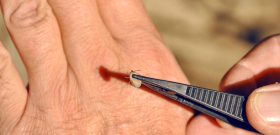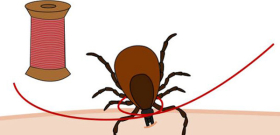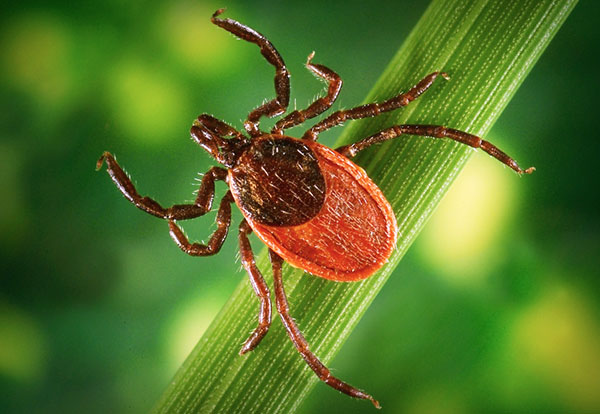
From a strict research point of view, an encephalitis tick is any tick in which the tick-borne encephalitis virus circulates and multiplies. In acarology and medicine, such a term is considered everyday, common people, and scientists themselves do not use it in their works. This is due to the fact that in fact the phrase "encephalitic tick" can be used to refer to a specific individual of the parasite infected with an infection, but not a separate species.
This meaning is at odds with the meaning that people put into the phrase "encephalitic tick" in everyday speech. In most cases, non-specialists believe that the encephalitic tick is a separate species, which, in terms of structural features, color and size, somehow differs from other, “ordinary” types of ticks. This misconception leads to the fact that often people are looking for ways to distinguish an encephalitic tick from a non-encephalitic one, trying to figure out what an infected parasite looks like and what are the features in its behavior that make it possible to accurately understand that this is precisely the carrier of the infection.
In fact, everything is not so simple and it is almost impossible to unambiguously calculate the encephalitic tick in nature. But this is not always necessary, and here's why ...
Types of ticks that can be carriers of tick-borne encephalitis virus
TBE virus can be carried by 14 types of ticks, two of which are the main vectors: the dog tick (Ixodes ricinus) and the taiga tick (Ixodes persulcatus). The first carries mainly the European subtype of the virus, the second - the Far Eastern and Siberian subtypes. The last two subtypes are considered especially dangerous due to the large number of deaths and irreversible damage they cause.
It is important that the appearance and size of these mites varies greatly depending on the age, stage of development and species of a particular individual.
For example, this is what an adult female common dog tick looks like:
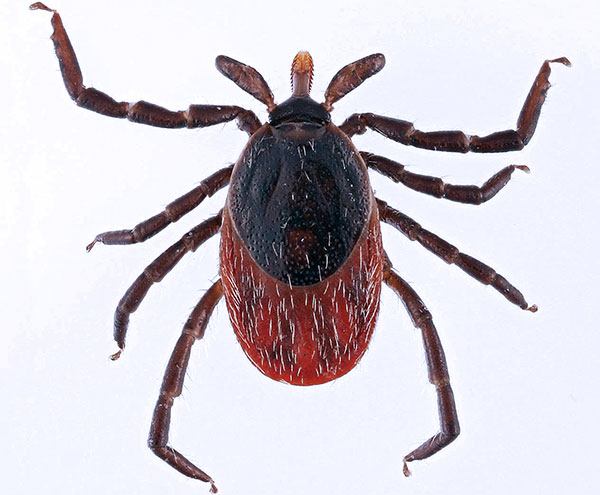
The length of her body is approximately 3.5 mm
This is it, only after full saturation:
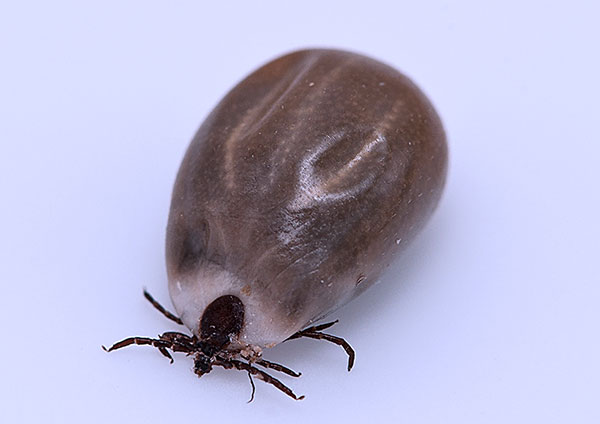
In this state, her body is extended in length up to 10-11 mm.
Here in the photo is an adult male about 2 mm long:

This is a nymph of the same species:

The body length of the nymph is about 1 mm.
All three of these individuals can bite a person.
The photo below shows a dog tick in three stages of development (from larva to adult of both sexes):

This photo shows an adult female taiga tick:

This is an adult male of the same species:
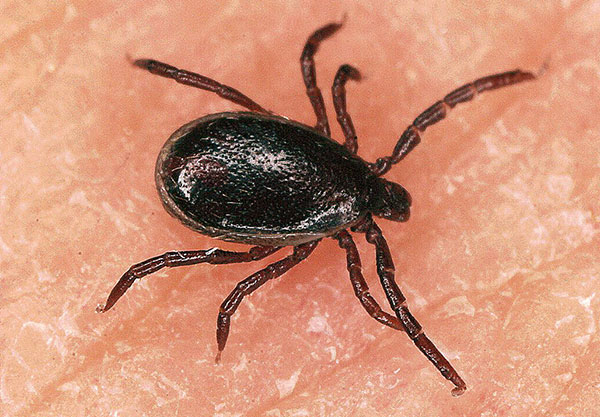
Here, finally, is the nymph of the first age:
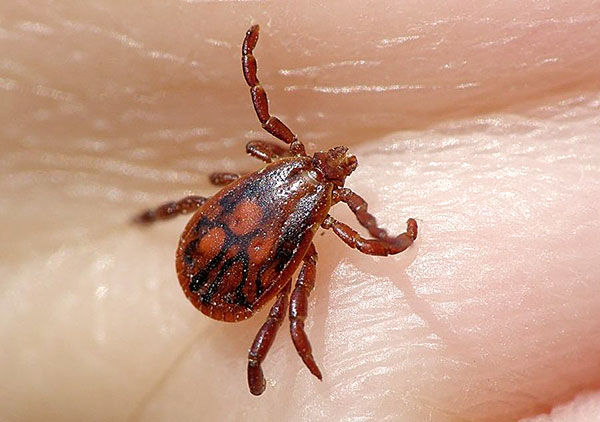
Any of these individuals can be infected with the tick-borne encephalitis virus, but it is even more likely to be uninfected.
It is interesting
Male taiga ticks either do not feed on humans and animals at all, or even if they stick, then for a short time, and consume very little blood. However, the risk of infection from them also remains. Moreover, a person pays attention to such a tick precisely when it is sucked to the body - in this case, infection is possible.
But this is not the whole variety of encephalitic mites.
For example, this photo shows an adult female Ixodes trianguliceps under a microscope:
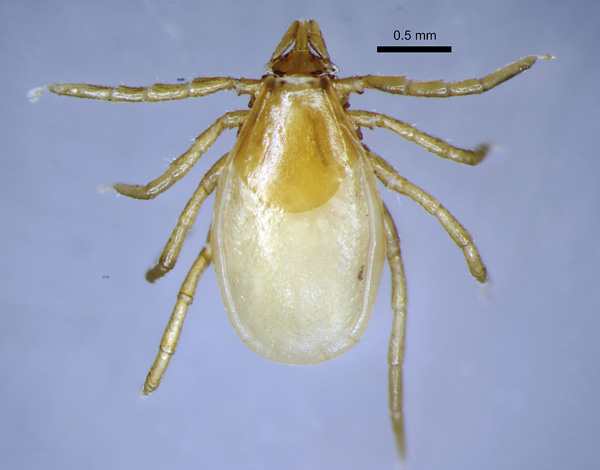
This photo shows an adult male of the same species:
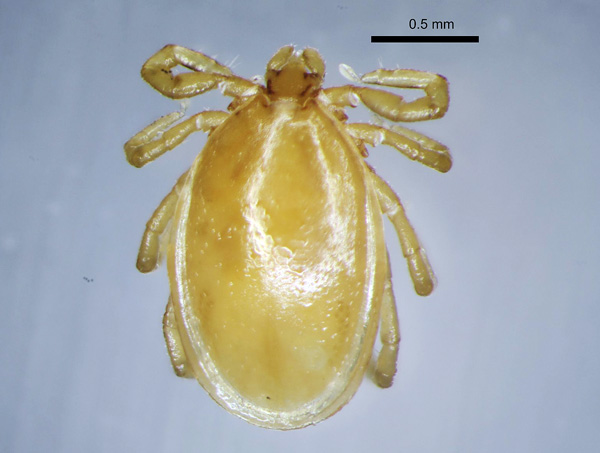
They can be distinguished, for example, from the dog tick by the light color of the idiosoma and the general shape of the body, resembling a triangle.
And this is Haemaphysalis concinna (adult female):
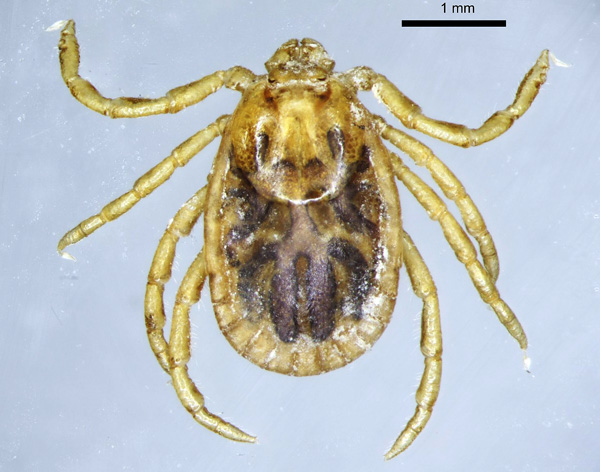
The photo below shows an adult male of the same species:

And Dermatocentor marginatus:

As you can see, the appearance of these parasites is very different. But each of them can be encephalitic.
Moreover: in the area of natural distribution of tick-borne encephalitis, almost any tick that bites a person can be encephalitic. This means that it is useless to try to distinguish a carrier of a virus from an uninfected parasite by appearance.
In addition, infection of the tick does not affect its appearance, behavior and activity. Studies show that even the survival of ticks does not decrease with the active development of the virus in their body. Moreover, the death of at least single individuals of ticks from the tick-borne encephalitis virus has never been observed. At the same time, the virus does not always, but in many cases, safely survive changes in its state that are significant for a particular individual: wintering with a decrease in body temperature, molting and transition to another age with the transformation of many tissues. What is there: the virus is transmitted even from the female to the eggs and the larvae hatching from them, and they can be carriers of it all their lives and pass it on to their descendants.
This means that ticks with the virus are almost impossible to distinguish from uninfected relatives. They are just as active, look the same and act the same.
However, with all this, the number of infected ticks in any population is very small and ranges from fractions of a percent to several percent.Only in the most dangerous regions and in natural foci of tick-borne encephalitis can the proportion of encephalitic individuals reach 10%. For example, in some areas in the Urals and the Far East, tick infestation reaches 12-15%. On average, throughout Russia and neighboring countries, the average infection of ticks in populations is about 6% and can fluctuate over the years within 2-3 times.
It is interesting that in areas with diverse landscapes, the degree of infestation of ticks varies significantly literally within tens of kilometers. For example, in the parks of Moscow, the proportion of infected parasites barely reaches 1%, and already in the forests of the Odintsovo and Serpukhov districts of the Moscow region, it reaches 2-3% of the total number of ixodids. Although it is regularly reported in the news that encephalitic ticks appear and are detected in previously safe areas, today they are found even in urban areas. This means that absolutely everywhere with a single tick bite, the probability of infection is always lower than the probability of a favorable outcome. Moreover, even the bite of an encephalitis tick does not necessarily mean that a person is infected: according to statistics, with the bites of confirmed infected parasites, tick-borne encephalitis develops on average in 4% of bitten people.
How does a tick become encephalitic?
The tick becomes encephalitic only after infection with the tick-borne encephalitis virus. This virus actively multiplies in the tissues of his body, penetrates into all organs, but accumulates in the greatest quantities in the intestines, salivary glands and genitals. It is with saliva that it is subsequently transmitted to the next victim, and from the genitals - to a partner during copulation or into eggs.

The tick-borne encephalitis virus can be betrayed by a tick to a mating partner and eggs when they are laid.
The main route of infection of ticks with the tick-borne encephalitis virus is transmissible, realized by sucking blood from an infected host. The tick-borne encephalitis virus can develop in the body of rodents, wild ungulates, some birds, and cattle. For example, once infected by a single tick, a cow or goat will later become a source of infection for hundreds and even thousands of ticks that will bite her throughout her life.
On a note
By the way, in most mammalian carriers of the tick-borne encephalitis virus, during the development of infection, infection occurs, including breast milk. If the female was infected during pregnancy or earlier, then her cubs are likely to also become infected with this infection. And it is through the milk of infected goats and cows that a person can pick up the virus.
Other ways of infecting ticks with tick-borne encephalitis virus:
- Transovarial - with it, viral particles penetrate the eggs developing in the body of the female and into the embryos. The larvae emerging from these eggs are already infected;
- Sexual, in which infection occurs during copulation of an infected and uninfected individual;
- Horizontal, one of the least studied. With it, two or more ticks stick to a still uninfected host very close to each other. For example, whole clusters of ticks are often found in the ears of dogs or hares. At the site of the bite of each tick, a subcutaneous food cavity is formed, in which some of the cells are destroyed, the walls of blood vessels are damaged, cells of the immune system and inflammatory mediators accumulate. The saliva of the tick accumulates in the same cavity.If the food cavities of two ticks that have stuck close to each other intersect, then one of the ticks can partially suck up the saliva of the other. And if one of them is infected with a virus, and the second is not infected, then an uninfected tick thus receives a pathogen and becomes infected.
Today it is known that the transmissible way of infection of ticks is the most common. How the frequency of infection is distributed among other modes of infection is not known. It is possible that together they provide a greater number of infections than the transmissible one alone.
On a note
Dogs do not suffer from tick-borne encephalitis, but they can be its carriers: for some time, the virus survives in the dog's body and can be transmitted to other ticks that bite it.
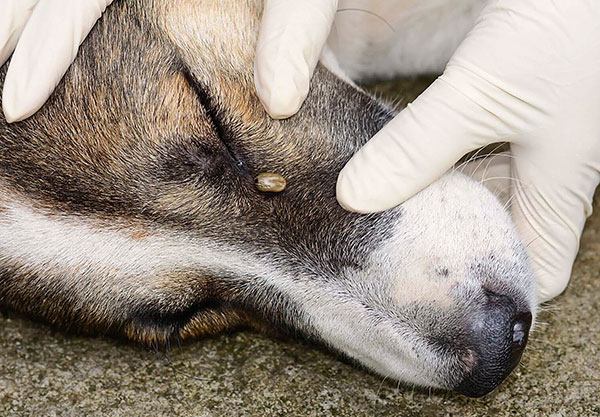
A dog can become a carrier of tick-borne encephalitis, while being immune to this disease.
At the same time, it was shown that the virus in the tick's body can disappear, and this happens no less often than, say, transovarial transmission of infection to offspring. For example, studies show that less than half of the infected ticks that have left for wintering remain infected in the spring. After each molt, less than half of the ticks remain infected with the virus, since not all strains are able to survive histological changes in the parasite during molting. It is for this reason that under natural conditions the proportion of infected individuals in the tick population not only does not grow with time, but is also subject to significant cyclical fluctuations.
How to understand that a tick is infected with the TBE virus
As we found out earlier, by the appearance of the tick or by its behavior directly when bitten on the human body, it is impossible to understand that it is infected with the tick-borne encephalitis virus. This means that it is impossible to be unequivocally sure whether it is worth taking measures to protect against infection after such a bite.
It is possible to unequivocally find out that the tick is encephalitic only after analyzing it in a special laboratory. Here, tick tissues are examined by several methods, and if virus RNA is detected in them, a conclusion is made that the parasite is infected. Such a study is usually carried out in one day, which, with due promptness of the bitten one, allows timely emergency prevention of tick-borne encephalitis.
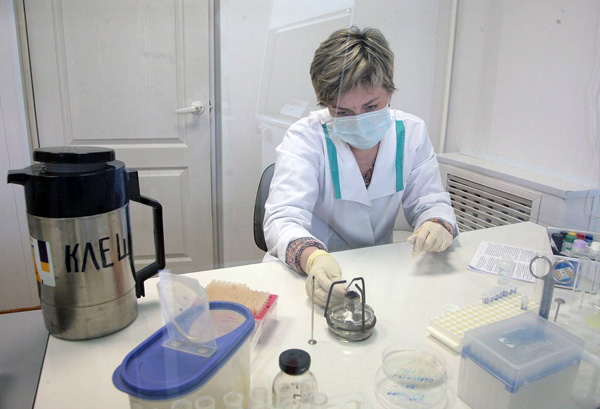
It is possible to find out if a tick is infected only after it has been examined in the laboratory.
Similarly, the appearance of the bite and the clinical manifestations with which it accompanies, it is also impossible to understand whether an infection has occurred. The first symptoms of tick-borne encephalitis will appear only at the end of the incubation period, when the disease begins. If, after a tick bite, it is not taken for analysis, then its infection can only be judged when such symptoms appear. This is dangerous, because after the onset of the acute phase of the disease there is always a risk of death.
The likelihood of tick-borne encephalitis with a single tick bite
Interestingly, even with the bite of an encephalitis tick, the likelihood of a person being infected with tick-borne encephalitis is very small. This is due to many factors, among which the most significant are the following:
- Usually, people detect the tick in the early stages of sucking and quickly remove it, and the parasite does not have time to inject into the tissues an amount of saliva containing an infectious dose of viral particles;
- The immune system of the body suppresses the virus immediately when it enters the tissues and prevents infection of cells;
- Virus particles themselves do not survive in the human body due to species characteristics. For example, the infection rate with the European subtype of tick-borne encephalitis is approximately 2-2.5%, and with the Siberian one - about 6%, that is, the Siberian subtype is more virulent.
According to statistics, with the bites of infected ticks, human infection occurs on average in 4% of cases, and only in some regions it reaches 6%. In other words, out of 100 unvaccinated people who were bitten by encephalitis ticks, four to six will get sick with tick-borne encephalitis.
If we multiply this figure by the number of encephalitis mites in the population itself, then the figure will be even smaller. Above, we found that, on average, throughout the area of tick-borne encephalitis, the infection rate of ixodid virus is about 4-6%. This means that if a person was bitten by a tick in nature, then with a 4-6% probability of infection of the parasite itself and about a 4% probability of infection, if the bloodsucker is encephalitic, the probability of infection from this one individual is approximately 0.2%. That is, out of 500 tick bites in nature, a bite of about one leads to the development of the disease.
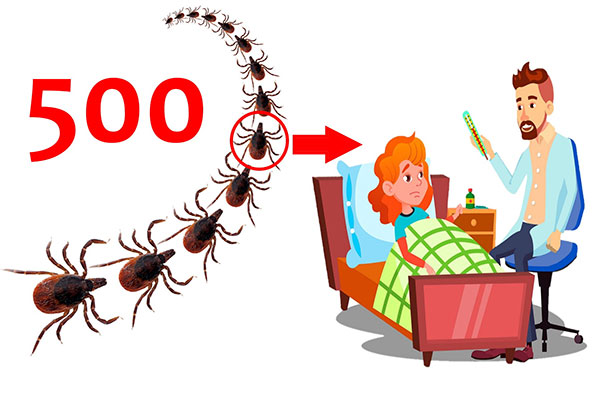
Statistics say that for approximately 500 tick bites, only 1 can lead to infection with tick-borne encephalitis.
On average in Russia, the annual number of people infected with tick-borne encephalitis ranges from 1800-2200 people. Perhaps some of them become infected in other ways (for example, through the same milk of infected cows), but their proportion is insignificant.
Interestingly, the ratio of the number of people who have registered tick-borne encephalitis to the number of people who went to the hospital or emergency room for tick bites is approximately 0.48%. This is 2.5 times higher than the figure of 0.2% calculated by us earlier, but it does not contradict the calculations in any way. The fact is that only a part of those bitten go to hospitals after tick bites, and the actual number of those who are bitten by ticks is greater, which means that the percentage of sick people among them will be smaller.
Be that as it may, the probability of getting sick when bitten by any ixodid tick (and in almost any area on the territory of Russia, Ukraine, Kazakhstan and neighboring countries) remains. Moreover, the same parasites that carry tick-borne encephalitis can also carry Lyme disease. And therefore, if such a bloodsucker is found on the skin, it should be removed immediately.
The sequence of actions when a bite is found on the body
If a tick is found on clothes or on the body, but it has not yet had time to stick, but simply crawls in search of a comfortable place, it is enough just to shake it off. If found during a picnic, it is better to kill it - while people are in one place, the parasite will be able to climb onto someone else again.
If the tick sticks, it must be removed immediately. And the sooner you can do this, the lower the risk of infection.
On a note
In many instructions and literary sources, you can find recommendations to go with a stuck tick to a clinic or emergency room and trust the doctor to remove it there. This is dangerous advice.As a rule, a tick bite occurs in nature far from settlements and hospitals, and you will have to spend at least 1-2 hours on the way to the doctor. While the bitten person will get to the hospital, the bloodsucker will have time to inject an infectious dose of the virus under the skin. And if you remove the parasite immediately after detection, this may not happen. Therefore, you need to remove the tick as early and quickly as possible, even if it is not as aesthetically pleasing and competent as shown in numerous videos on the Internet.
In the optimal case, a person has a special ticker at hand - a device with which the parasite is captured, rotates around the axis of its body and falls out entirely, without the risk of squeezing out part of the pumped blood into the wound and without the risk of tearing off the head.

The tick puller is one of the most effective devices for extracting a tick.
However, in most situations, such a tick is not at hand. In this case, the tick should be picked up with nails under the body, rotated at least 90-180 degrees and pulled out. Almost always, this can be done without tearing off the head, but even if the mouthparts come off and remain in the skin, they can be removed with a needle in the same way as a splinter is removed.
It is important to understand that taking a tick in the skin to the hospital for an hour or two is more dangerous than, even in the worst case, tearing off the head of the tick and picking it out with a needle. If the body of the tick breaks away from the gnathosoma, the mouth organs remaining in the skin no longer pose an infectious danger to humans: they do not have salivary glands (they remain in the body) and there is no virus. Already such a head can be removed for a long time and carefully, without risking infection.If you are afraid to break the tick, then by the time a person gets to the doctor or makes a home-made tick, the parasite will already have time to infect him with tick-borne encephalitis or borreliosis.
In this case, cases of detachment of the body of the parasite from the head are very rare. Both of the most common vectors of tick-borne encephalitis - canine and taiga ticks - do not form a cement case around the hypostome in the skin when they bite, and therefore their jaws are easily pulled out and this requires less effort than tearing the body of the parasite. That is, if you just take and tear off the tick, almost certainly no jaws will remain in the skin.
Further actions depend on whether the bitten person has been vaccinated against tick-borne encephalitis. It is enough for a vaccinated person to remember the date of the bite in order to be tested for infection with Lyme borreliosis in about a month. If there is no vaccination, then the sequence of actions should be as follows:
- After removing the tick from the skin, it must be placed in any tightly closed container, in extreme cases - in a bag, which is then tightly tied;
- After that, you need to find out if the region in which the bite occurred is dangerous for tick-borne encephalitis. In fact, it is possible to catch this infection anywhere in the temperate zone of Eurasia, from Sochi to Vorkuta, but in some zones the epidemiological threshold is relatively low, and the probability of infection is higher than in others. You can find out on special maps, they can be easily found on the Internet. If the bite occurred in a dangerous region, the tick must be taken to a special laboratory where it is examined for infection with the virus. Further actions will depend on the outcome of the study;
- If the tick is infected with a virus, the bitten person must be injected with anti-encephalitis serum (the so-called emergency prevention of tick-borne encephalitis). It reduces the risk of developing the disease (although it does not completely protect against it), and if it develops, the disease will be milder and most likely not lead to serious consequences. If the virus could not be detected, then the tick is not encephalitic and there is no danger of developing the disease for humans. Nothing more needs to be done in the near future.

Such a serum is sometimes used for emergency prophylaxis of TBE.
In any case, after a bite, it is necessary to monitor your own condition for a month. With the development of any non-specific symptoms of the disease, it is necessary to consult a doctor and report when the bite occurred.
How does tick-borne encephalitis manifest itself?
Tick-borne encephalitis can develop after emergency prophylaxis, and even after vaccination (which, however, happens very rarely). The sooner the symptoms of the disease are detected and the sooner treatment begins, the higher the likelihood of a favorable outcome. Signs of tick-borne encephalitis include:
- Fever, fever, headache, nausea, indigestion;
- Disturbances in coordination of movements, fainting;
- General malaise, muscle pain.
As a rule, these symptoms appear 5-15 days after the bite and are observed for 2-4 days, after which the patient's condition returns to normal, but after a week, damage to the nervous system develops with various symptoms up to paralysis. If the disease is brought to this stage, there is a danger of disability and death of the patient.Therefore, already when the first symptoms appear, the doctor directs the patient to a blood test and, if so-called “young” antibodies to tick-borne encephalitis are detected, therapy begins. In most cases, it is done on an inpatient basis in a hospital.
On a note
In rare cases, tick-borne encephalitis resolves on its own without specific treatment. Sometimes patients do not even know that they fell ill with it (for example, hunters-fishers in Siberia, who do not pay attention to short-term manifesting symptoms), safely “on their feet” endure the disease and heal themselves. However, most of them have partial immunity, both from the bites of small tick larvae and from seropositive parents, and therefore they are more likely to recover safely than a person who first encountered this virus.
The disease caused by the taiga and Far Eastern subtypes of the virus often proceeds without a remission pause: generalized symptoms turn into neurological ones and the patient's condition rapidly worsens. Therefore, people bitten in the Asian part of the range need to be especially careful to monitor their own condition and respond as quickly as possible to not the first signs of the disease.

The main signs of TBE infection after a tick bite.
If the bitten person does not have any symptoms of the disease, then in a month he needs to take a blood test for antibodies to borreliosis. In this case, you can be sure that tick-borne encephalitis has not developed (its incubation period lasts 1-2 weeks), but the risk of developing borreliosis remains (this disease can not only manifest itself after 6-10 months, but even after the end of the incubation period, it does not manifest, and only later lead to the development of severe complications). To recognize a blurred or delayed form of borreliosis, you need to take a blood test. With a positive result of the study, the disease must be treated on an outpatient basis.
Ways to protect against encephalitis ticks
The attentive reader has probably already concluded that the most effective way to avoid the dangers associated with encephalitis ticks is to get vaccinated against tick-borne encephalitis. In its presence, the disease almost never develops, and in rare cases, the development proceeds mildly and without serious consequences.
However, such a vaccination does not protect against Lyme borreliosis, and therefore, even if it is available, measures must be taken to prevent or minimize the likelihood of tick bites. For this you should:
- On trips and outings to nature in places where ticks are found, wear clothes that protect as much as possible from ticks - trousers tucked into socks, a shirt tucked into trousers and having cuffs on the sleeves;
- Wear light-colored trousers, on which a hooked and crawling tick will be clearly visible;
- Treat clothes with pyrethroid-based repellents, skin on exposed areas of the legs and arms with DEET preparations. For a child, you need to use similar preparations, only containing a reduced amount of repellent;
- Use special accessories that allow you to catch ticks - lining-traps on trousers, flashlights with mesh-traps;
- Avoid trails trodden by wild or domestic animals, places of rest for animals - ticks often accumulate here;
- Carry out frequent regular examinations of the body independently, or mutual examinations of each other;
- Small children, whose clothes cannot be sprayed with repellents, are taken out into nature in cradles and strollers that parasites cannot get into.
Moreover, all these measures are relevant everywhere, including in areas where tick-borne encephalitis is rare. The fact is that almost everywhere where ixodid attacking a person is found, you can pick up borreliosis. And to protect yourself from it is no less important than from tick-borne encephalitis.
Useful video: how to protect yourself from tick-borne encephalitis

